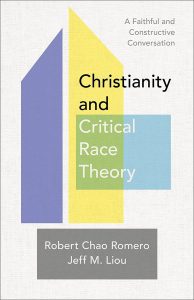I first came to use Critical Race Theory as an academic tool about a decade ago.
Around that time, I was helping lead a tour of urban Latina/o students at the university I worked at, together with a Christian urban youth organization. After meeting the students, I walked with them to the elevator doors of a building on campus. Around 20 Latina/o high school students were with me, and when we arrived at the elevator, I pressed the elevator button a few times, like I normally do. In response, another worker from the university told me I didn’t have to press the button so many times; it would work if I pressed it just once.
About half the students walked with me onto the elevator. We pressed the button for our floor, and the staff member pressed the button for his floor. We noticed that, for some reason, the buttons for several other floors were also lit up (think of the famous scene from Elf ). Had one of the teenagers pressed them? Or were they lit up for some other reason? The staff member made some seemingly angry and disrespectful comments, appearing to blame the students. (As it turns out, the students had not pressed the buttons.) I was very mad, and I told the worker, “These students are here at college for the first time.”
The staff member then looked at the students and said that they would need to buck up if they wanted to come to college.
I was infuriated. As I expressed my displeasure, he got off on his floor without saying a word. I then apologized to the students for what they had just experienced. But then, with tears in their eyes, they told me, “It’s OK; we’re used to it.”
“With tears in their eyes, they told me, ‘It’s OK; we’re used to it.’”
I was deeply touched by the homemade, handwritten cards I later received, which said, “Thank you for speaking up for us.”
As God would have it, around that same time I was teaching my first graduate class on Chicana/o legal history and Critical Race Theory. CRT gave me the language to describe what I experienced that day, for not the first or the last time: a microaggression.
As a professor, lawyer, historian and pastor, I’ve continued to teach and write professionally about CRT ever since teaching that class. As mentioned above, CRT has given me the language to describe my own racialized experiences and those of many people I know. Over the years, I’ve come to one basic conclusion: CRT is helpful.
I have found CRT helpful as a bridge for witnessing and evangelism. Just as John used the Greek concept of the logos as a bridge to share about Jesus with his Greco-Roman audience, and as Paul connected with his hearers at the Areopagus by citing Greek philosophers and poets, so have I been able to share the gospel by using CRT as a cultural bridge to connect with thousands who never would have darkened the door of a church.
 As a follower of Jesus, I am greatly intrigued by the truths in CRT that comport with the teachings of the Bible. Of course, not everything in CRT is in alignment, but many of the big tenets of CRT line up squarely with the teachings of Jesus and Scripture. Since all truth is God’s truth, this does not surprise me at all.
As a follower of Jesus, I am greatly intrigued by the truths in CRT that comport with the teachings of the Bible. Of course, not everything in CRT is in alignment, but many of the big tenets of CRT line up squarely with the teachings of Jesus and Scripture. Since all truth is God’s truth, this does not surprise me at all.
For the sake of illustration, I will offer two examples of the alignment between CRT and the teachings of the Bible.
The first major tenet of CRT — racism is ordinary — means racism is an ordinary part of everyday life for people of color in the United States. We experience racism on a regular basis as we go about our daily lives. We feel it in our one-on-one interactions with people and in big and small ways. As demonstrated by the stories of Angelica and John, and by my own story, racism shows up on an institutional level too — in our schools, hospitals, courtrooms and political institutions and, unfortunately, even in some of our churches, seminaries and ministries.
“This idea of racism being ‘ordinary’ and ‘just the way it is’ lines up exactly with a biblical worldview.”
In fact, this idea of racism being “ordinary” and “just the way it is” lines up exactly with a biblical worldview. From the standpoint of the Bible, sin is ordinary. It is our natural bent, apart from God’s transformative work in our hearts and lives.
As the Apostle Paul states, “For all have sinned and fall short of the glory of God, and all are justified freely by his grace through the redemption that came by Christ Jesus.” Prejudice and racism are two of the ugliest types of sin. They violate the sacred biblical truth that all people are equal in God’s sight because all people are made equally in God’s image.
Prejudice says: “My culture reflects the image of God more than yours; my people are better because your people are ‘criminals, rapists, drug dealers and uneducated.’” Racism says: “Because my people are culturally superior to yours, I will create laws and policies and will structure society in a way that privileges ‘my people.’ I will make sure ‘your people’ have little to no access to these same privileges and benefits because you are culturally inferior and don’t really belong.”
Another biblical analog from CRT is that of community cultural wealth. CRT scholars Tara Yosso and Danny Solórzano developed the concept of community cultural wealth in the context of urban educational studies. Yosso and Solórzano challenge the traditional educational literature that claims Latino students are culturally deficient. Instead, they argue Latino students bring unique forms of community cultural wealth to their K–12 and university educations that are distinct from, but not inferior to, the social capital of white students.
Similarly, sacred Scripture teaches that every ethnic group possesses God-given community cultural wealth. In the book of Revelation, John calls this wealth the “glory and honor of the nations,” which he says “will be brought into” the New Jerusalem. The word translated into English as “glory” can also be translated as “treasure” or “wealth.” A plausible reading of this passage is that after Jesus returns and makes all things new, the cultural treasure and wealth of every ethnic group of the world will be brought into the New Jerusalem forever.
In fact, brown and Black churches have been repositories of such diverse glory and honor for more than four centuries, and the burgeoning global and immigrant churches likewise offer an embarrassment of cultural and spiritual riches for the benefit of the entire body of Christ.
We should start living into this wonderful reality now. Far too often, people of color are forced to leave their own God-given cultural treasure and wealth outside white ministries and church doors in order to find acceptance. This is why millions are fleeing the evangelical church and parachurch ministries today. Although God does not have ethnic favorites, neither is God color-blind. Nor should we be.
Robert Chao Romero is associate professor in the UCLA departments of Chicana/o, Central American, and Asian American Studies; director of the Brown Church Initiative at Fuller Theological Seminary; an attorney; and author of the award-winning book Brown Church.
Jeff M. Liou is national director of theological formation for InterVarsity Christian Fellowship/USA, an adjunct assistant professor of Christian ethics at Fuller Theological Seminary, and cofounder of the Asian American Christian Collaborative.
This article is excerpted from Christianity and Critical Race Theory by Robert Chao Romero and Jeff M. Liou Root, ©2023. Used by permission of Baker Academic www.bakeracademic.com.
Related articles:
Attacks on Critical Race Theory didn’t come out of nowhere, panelists say
White hysteria, Critical Race Theory, and eyes that dare not see | Opinion by David Gushee
‘Critical Race Theory is the kryptonite of white evangelicals,’ professor declares


